Introduction
Imagine waking up to the serene beauty of a miniature orange grove, right on your windowsill, its delicate fragrance mingling with morning sunlight to create a moment of pure bliss. This is the unique charm of bonsai orange trees – not just plants but living artworks that capture the imagination and bring the essence of nature into our homes.
I’m Anitha, a bonsai enthusiast with over a decade of experience in cultivating these tiny marvels. My journey began with a single bonsai orange tree, a family heirloom passed down to me, which blossomed under my care into a passion for all things bonsai.
My guidance comes not only from personal triumphs and the occasional learning curve but also from trusted voices in the horticultural field. I’ve spent years devouring publications from esteemed organizations such as the American Bonsai Society and the International Society of Arboriculture, ensuring that the advice I share is not just based on personal anecdotes but is also grounded in professional standards and scientific research.
Unveiling the Allure of Bonsai Orange Trees


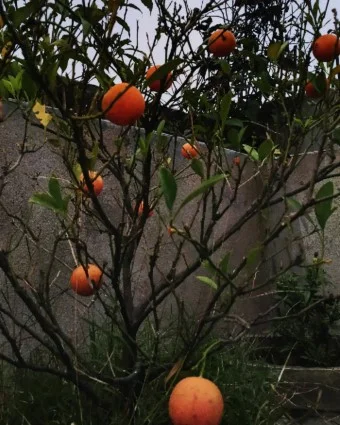
Bonsai Orange Tree: More Than Just an Ornament
Bonsai orange trees are so much more than quaint decorations perched on a shelf. They encapsulate the power to transform any space, blending ornamental grace with the practical benefit of producing actual, edible fruit. Imagine the delight of plucking a tiny, sun-warmed orange from your miniature tree – a tangible reward of your gardening prowess. The fruit, albeit small, carries a zesty punch and a sweetness that tastes of victory, a small but mighty testament to the wonders of nurturing life in compact form.
Unveiling Hidden Benefits
Beyond their visual and gustatory appeal, bonsai orange trees bestow profound therapeutic value. The deliberate, mindful care they require becomes a practice in meditation, a peaceful respite from the clamor of daily life. Watching a tree flourish under your care can boost feelings of accomplishment and emotional well-being. Furthermore, these mini citrus marvels often become the centerpiece of conversations, drawing intrigue and admiration from visitors, sparking dialogues about nature, patience, and the art of bonsai. In essence, a bonsai orange tree is not just a plant; it is a living emblem of patience and dedication, a constant reminder that the most beautiful things in life require time, care, and love to thrive.
In-Depth Care Guide for Thriving Bonsai Orange Trees
Location:
Sun-Kissed Citrus:
For bonsai orange trees to thrive, ample sunlight is non-negotiable. They crave the sun’s rays, needing ideally 5 to 6 hours of direct sunlight each day to foster healthy growth and fruitful production. This golden rule helps their leaves photosynthesize more efficiently, which is crucial for their overall vitality and the ripening of their miniature oranges.
Winter Wonderland:
As temperatures dip, it’s crucial to bring your bonsai orange tree indoors to escape the frost’s grip. The perfect indoor spot is near a south-facing window where it can bask in bright, indirect sunlight for most of the day. Keep your citrus companion away from cold drafts and heat sources, which could result in leaf drop. Remember, even when indoors, providing a semblance of its natural habitat will help it flourish.
Watering Wisdom:
The Art of Balance:
Watering your bonsai orange tree is akin to performing a delicate dance—it’s all about balance. Overwatering and underwatering are the two missteps to avoid. Ideally, water when the top inch of soil feels dry to the touch. Using soft, room-temperature water, aim for a thorough soaking that ensures moisture reaches the roots before allowing excess water to drain away.
Reading the Signs:
Learning to interpret your tree’s signals can avert watering woes. Wilting leaves often cry out for hydration, while mushy soil indicates overindulgence. Stay observant and adjust your watering routine based on these signs, coupled with seasonal changes in your tree’s environment.
Soil Secrets:
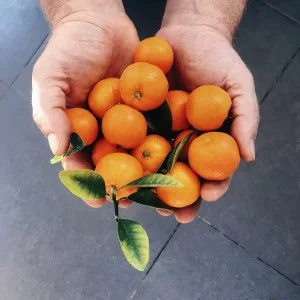
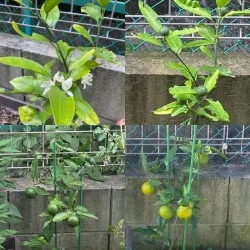
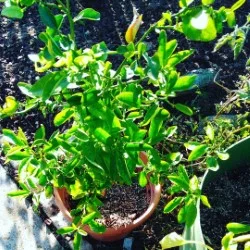
The Foundation of Growth:
The right soil mixture is paramount for your bonsai’s health, requiring a blend that offers excellent drainage and nutrient retention. A mix of akadama, pumice, and fine gravel can create a conducive environment for root growth. For those less inclined to DIY, high-quality, commercial bonsai soil mixes are readily available.
Drainage Matters:
A well-draining soil mix and a pot with adequate drainage holes are vital to prevent root rot and maintain healthy airflow around the roots. This setup ensures that water does not pool at the base, fostering an environment that encourages vitality and growth.
Fertilizing for Fruitful Success:
Feeding Your Citrus Champion:
A balanced, slow-release fertilizer with an equal ratio of nitrogen, phosphorus, and potassium will cater to your bonsai orange tree’s needs during the growing months. Feeding it every four to six weeks in spring and summer supports lush growth and bountiful fruiting.
Less is More:
Adhering to the recommended fertilizer application rates is crucial. Overfertilizing can damage the roots and lead to nutrient burn, adversely affecting your tree’s health. Remember, in the world of bonsai, patience and precision are virtues.
Pruning for Perfection (Originality):
The Art of Shaping:
Pruning is not just about size control; it’s an art form that accentuates a tree’s beauty, encourages fruit production, and maintains vitality. Experiment with styles like the cascading or upright form, or even the windswept look, to find what best suits your vision for your miniature orange grove.
Timing is Key:
The ideal pruning period for bonsai orange trees is before new growth starts in spring or immediately after the fruit has been harvested. This timing allows the tree to heal and direct its energy towards producing the next cycle of blooms and fruits.
Troubleshooting Common Bonsai Orange Tree Issues



Yellowing Leaves: Nature’s Alert System
Yellowing leaves on your bonsai orange tree are more than a cosmetic issue; they’re a distress signal. Often, this symptom points to a nutrient deficiency, particularly nitrogen, which is critical for healthy, vibrant foliage. Enhancing your soil with a balanced fertilizer, as previously mentioned, can address this issue. Alternatively, underwatering may be the culprit. These trees enjoy consistent moisture, so ensure the soil is neither too dry nor waterlogged. Monitoring your watering practices and adjusting as necessary can help restore the lush green vibrancy of your mini citrus haven.
Pests and Diseases: The Unwanted Guests
Bonsai orange trees can be susceptible to the same pests and diseases as their full-sized counterparts, with aphids, spider mites, and scale insects being among the most common invaders. These pests not only damage the tree but can also hinder fruit production. Adopting an organic approach, such as introducing beneficial insects like ladybugs or applying neem oil, can offer natural defenses against these threats. Regularly inspecting your tree for signs of infestation and maintaining cleanliness around your bonsai can prevent many of these issues before they start.
Fruit Drop: A Delicate Balance
It’s disheartening to see immature fruits fall before they’ve had a chance to mature. Often, this can be a natural process of the tree prioritizing its resources, but it can also indicate stress. Factors like inconsistent watering, either too much or too little, extreme temperature fluctuations, or insufficient light can stress the tree, leading to fruit drop. To encourage fruit development, maintain a stable environment with consistent care, ensuring your tree receives adequate water, sunlight, and nutrients. A stable environment supports not just survival, but flourishing, allowing your bonsai orange tree to produce those delightful miniature oranges we cherish.
The Sweet Rewards: Witnessing Your Bonsai Orange Tree Thrive
The Joy of Harvest: Savoring the Fruit of Your Labor
The culmination of your dedication, patience, and care is a moment of pure joy—the harvest. Picking a ripe, fragrant miniature orange from your bonsai tree is an unparalleled satisfaction. The fruit, a tangible symbol of your nurturing, embodies the essence of homegrown quality and freshness, offering flavors that store-bought ones seldom match. Beyond the zest and sweetness, there’s a profound connection to nature, a reminder of the earth’s generosity and the rewarding cycle of growth and renewal.
Beyond the Fruit: Mastery and Marvel
However, the rewards of maintaining a bonsai orange tree extend far beyond the delightful citrus bounty. There’s an aesthetic pleasure in witnessing the intricate weave of leaves, branches, and fruits, a living sculpture shaped by your hands. The tree becomes a source of pride, an artwork that evolves and deepens in beauty with each passing season. This miniature citrus grove not only produces fruit but also blooms with the promise of renewal, offering a deep sense of accomplishment and an intimate experience with the rhythms of nature. In the meticulous care of your bonsai, there’s tranquility and purpose, making the enduring commitment to its flourish not just a hobby, but a passage to mindfulness and creativity.
Conclusion
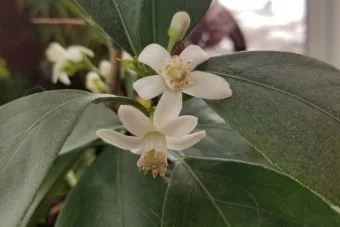


Recap and Encourage:
In nurturing a bonsai orange tree, remember the essence lies in the balance of adequate sunlight, proper watering, effective drainage, timely fertilization, and the art of pruning. Each element is a stepping stone towards creating not just a flourishing mini citrus grove but also a piece of living art gracing your space. From addressing yellowing leaves and battling pests, to the nuanced care preventing fruit drop, every challenge is an opportunity for learning and growth.
Call to Action:
We’ve traversed together through the joys and trials of bonsai orange tree care, witnessing the sweet rewards of fruit and fulfillment. Now, it’s your turn to share the story of your miniature citrus marvel. Whether it’s your success stories, the hurdles overcome, or simply the tranquil beauty of your bonsai, we invite you to share your experiences in the comments below. For those eager to expand their knowledge or perhaps start their bonsai orange tree journey, consider exploring resources like online forums, local nurseries, or horticultural clubs. Together, let’s cultivate a community passionate about the art and science of bonsai care.
